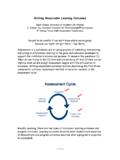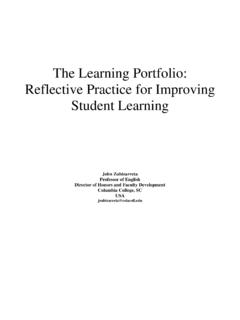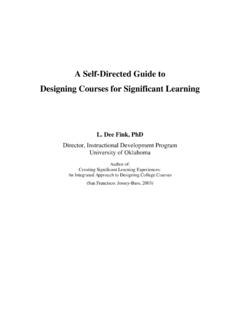Transcription of STUDENT LEARNING OUTCOMES - Jones & Bartlett …
1 STUDENT LEARNING OUTCOMESA fter reading this chapter the STUDENT will be able to: Explain the concept of Self-Efficacy Theory. Identify the constructs of Self-Efficacy Theory. Explain how vicarious experience influences self-efficacy. Describe the influence of mastery experience on self-efficacy. Demonstrate how verbal persuasion impacts self-efficacy. Explain how the somatic and emotional states affect self-efficacy. Use Self-Efficacy Theory to explain one health TheoryTHEORY ESSENCE SENTENCEP eople will only try to do what they think they can do, and won t try what they think they can t 134/26/2013 9:59:04 AMIN THE BEGINNINGFor eons of time, we have been trying to understand and explain why people do what they do. Early on, the theories used to explain behavior had a psychodynamic basis and shared three characteristics that behavior is regulated psychically at a sub-conscience level; that behaviors diverging from the prevailing norm are a symptom of a disease or disorder; and that behavior changes as a result of gaining self-insight through analysis with a therapist (Bandura, 2004).
2 !ese theories formed the foundation of the lie on the couch approach of talk therapy thought to be the magic bullet of behavior change. Unfortunately, research on the outcome of talk therapy showed that although people did gain insight into their behavior, their behavior usually didn t change (Bandura, 2004).In the 1960s an alternative behaviorist approach to the explanation of human behavior was introduced. !is new approach viewed behavior as the result of an interplay between personal, behavioral, and environmental factors rather an unconscious process with psychodynamic roots, and it did not consider deviant behavior a disease symptom (Bandura, 2004).A shift in treatment also occurred at this time in terms of content, location, and (behavior) change agent. Treatment content became action oriented and focused on changing the actual deviant behavior rather than on trying to $nd the psycho-logical origins of the behavior.
3 Mastery experiences were used to give people the skills and belief in themselves to adopt healthier behavior. Treatment occurred in the settings where the behavior occurred at home, school, workplace, and com-munity rather than in a therapist s o%ce. And this new approach did not limit treatment change agents to being mental health professionals only. For example, teachers were trained to assist in reducing problem behaviors in the school setting Self-Efficacy Constructs ChartMastery experience:Prior success at having accomplished something that is similar to the new behaviorVicarious experience: LEARNING by watching someone similar to self be successfulVerbal persuasion:Encouragement by othersSomatic and emotional states:The physical and emotional states caused by thinking about undertaking the new behavior14 CHAPTER 2 SELF-EFFICACY 144/26/2013 9:59:05 AMand peers or role models who had overcome the problem behavior themselves were also change agents (Bandura, 2004).
4 Although both approaches were very di&erent, research done on phobias showed that both were equally as e&ective. Since both approaches worked, it was apparent there was some underlying mechanism connecting them. It was Albert Bandura in the late 1970s who proposed Self-E%cacy !eory as the unifying mechanism (Bandura, 1977, 2004).THEORETICAL CONCEPTIf you were given the opportunity to fund your college education by swimming 10 laps in a pool, you surely would give it a try, assuming you can swim. Now imagine you were given the same opportunity to raise tuition money, but had to swim the English Channel instead. Would you still go for it? If your swimming ability is like the average person s, there s no way you d even attempt it. Why the di&erence? In the $rst case, you believe you can swim the 10 laps. In the second, you don t believe you can swim the English Channel, and so you won t even try.
5 !ink back to your childhood and the book e Little Engine at Could: I think I can. I think I can. !is is the concept of self-e% is the belief in one s own ability to successfully accomplish some-thing. It is a theory by itself, as well as being a construct of Social Cognitive !eory. Self-E%cacy !eory tells us that people generally will only attempt things they believe they can accomplish and won t attempt things they believe they will fail. Makes sense why would you try something you don t think you can do? However, people with a strong sense of e%cacy believe they can accomplish even di%cult tasks. !ey see these as challenges to be mastered, rather than threats to be avoided (Bandura, 1994).E%cacious people set challenging goals and maintain strong commitment to them. In the face of impending failure, they increase and sustain their e&orts to be successful.
6 !ey approach di%cult or threatening situations with con$dence that they have control over them. Having this type of outlook reduces stress and lowers the risk of depression (Bandura, 1994).Conversely, people who doubt their ability to accomplish di%cult tasks see these tasks as threats. !ey avoid them based on their own personal weaknesses or on the obstacles preventing them from being successful. !ey give up quickly in the face of di%culties or failure, and it doesn t take much for them to lose faith in their capabili-ties. An outlook like this increases stress and the risk of depression (Bandura, 1994). THEORETICAL CONCEPT 154/26/2013 9:59:05 AMTHEORETICAL CONSTRUCTS!e theory introduces the idea that the perception of e%cacy is in*uenced by four factors: mastery experience, vicarious experience, verbal persuasion, and somatic and emotional state (Bandura, 1994, 1997; Pajares, 2002).
7 MASTERY EXPERIENCEWe all have mastery experiences. !ese occur when we attempt to do something and are successful; that is, we have mastered something. Mastery experiences are the most e&ective way to boost self-e%cacy because people are more likely to believe they can do something new if it is similar to something they have already done well (Bandura, 1994).Perhaps you never thought about this, but babysitting is a signi$cant mastery experience (Figure 2 1). Babysitting is among the strongest predictors of a new mom s belief in her ability to take care of her own children. Women who have experience taking care of infants prior to becoming mothers themselves are more con$dent in their maternal abilities, and even more so in completing infant care tasks they did frequently (Froman & Owen, 1989, 1990; Gross, Roccissano, & Roncoli, 1989). So, babysitting as a teenager pays o& in many is the basis for preoperative teaching of men undergoing surgery for prostate cancer.
8 Since this type of surgery can result in urinary incontinence, it is important for men to do pelvic exercises postoperatively to restore urine control. FIGURE 2"1 Babysitting provides mastery experiences Jamie Wilson/Shutterstock, CHAPTER 2 SELF-EFFICACY 164/26/2013 9:59:09 AMIf they are taught these exercises before surgery and practice them, their self-e%cacy increases and they are more likely to regain urine control more quickly after surgery (Maliski, Clerkin, & Litwin, 2004).Providing opportunities for people to gain mastery is the reason why work-shops, training programs, internships, and clinical experiences are o&ered. !ese are ways people can become pro$cient at new skills and increase their self-e%cacy. For example, training programs are one way of providing mastery experiences for people with disabilities who are entering the labor market (Strauser, 1995).
9 Hours in the clinical practice areas provide opportunities for STUDENT nurses to master nursing skills, and internships a&ord health education students the chance to master the competencies needed for professional a fall prevention program for older adults, mastery experiences in the form of practice opportunities for negotiating outdoor activities such as using public transportation, stairs, and crossing streets proved to be one of the most e&ective strategies of the program for increasing participants self-e%cacy (Cheal & Clemson, 2001). Falls are a major contributor to morbidity in people 65 and older, with one in three older adults falling each year. Of those who do fall, 20 to 30% have injuries severe enough to impact their ability to live independently (Centers for Disease Control and Prevention [CDC], 2012).
10 Increasing self-e%cacy through mastery experiences is one way of assisting older adults at risk of falling to gain con$dence in safely participating in everyday activities (Cheal & Clemson, 2001). For personal trainers, mastery experiences are e&ective ways to support client exercise self-e%cacy. Starting with a simple exercise program that can be successfully completed creates a mastery experience that can lead to success with more challenging programs (Jackson, 2010). It would seem that mastering something new is relatively simple: all you have to do is practice. However, this isn t always the case. If the new tasks are always easy and similar to ones already mastered, and di%cult, unfamiliar ones are avoided, then a strong sense of e%cacy does not develop. To develop a strong sense of e%cacy, di%cult tasks also need to be attempted, and obstacles worked through (Bandura, 1994).

















